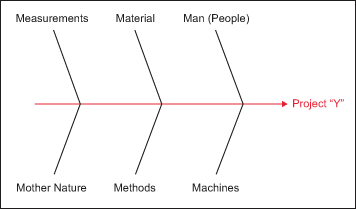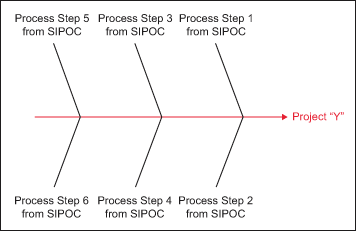
Six Sigma practitioners strive to find the root causes of defects fast and accurately. One of the tools that provides a good initial view of the process Six Sigma is being used to optimize is SIPOC (supplier, input, process, output, customer). This tool is especially helpful when the improvement project is aimed at a process with which the project leader has little to no experience.
SIPOC can assist in completing the project charter in numerous ways. The suppliers and customers are potential team members and/or stakeholders, the outputs are the metrics which will be used to measure the project, the inputs allow the project team to consider various potential critical Xs, and, of course, the process itself provides the stop-start barriers.
Cause-and-effect Diagram and Six M’s
Once the charter is complete and signed by all parties, the team transitions to the Measure phase, where the search starts for potential Xs that influence output. One of the tools is the fishbone diagram. The classic cause-and-effect fishbone has the defect at the end (the stinky head of the fish), and the bones are split up in six categories:
- Man (people)
- Machines
- Material
- Methods
- Measurements
- Mother Nature

With each “bone,” the team tries to find various potential Xs that influence the project Y by asking:
- “How does man (people) negatively influence the defect?”
- “How do the machines negatively influence the defect?”
- “How does the material negatively influence the defect?”
- “How do the methods negatively influence the defect?”
- “How do the measurements negatively influence the defect?”
- “How does Mother Nature negatively influence the defect?”
After completing this exercise, the team should have various inputs that can be classified as the six bones. The project team may have more inputs on the material bone, or have more on the people one, but in the end the team will have an idea of where the critical X could be. The next step then is to sort and prioritize the various Xs and start measuring them in conjunction with the Y.
Using Process Steps in Fishbone
Another way to use the fishbone diagram to search for potential Xs is to combine it with the SIPOC. During the construction of the SIPOC, the team lists between four and eight high-level process steps. Now, instead of using the standard bones (man, machine, material, methods, measurements and Mother Nature), the team uses the process steps listed in the SIPOC.

The list of questions remains the same:
- “How does Process Step 1 negatively influence the defect?”
- “How does Process Step 2 negatively influence the defect?”
- And so forth.
Doing this has several benefits:
- The project team can identify and associate with the process steps more easily than with the generic bones.
- Due to this association, the team can normally think of more inputs than with the generic bones.
- After completing the fishbone with the process steps, it is really easy to pinpoint where the problem may be occurring.
By combining the cause-and-effect diagram and SIPOC, a Green Belt or Black Belt will quickly and more effectively find which critical Xs actually influence the project Y.